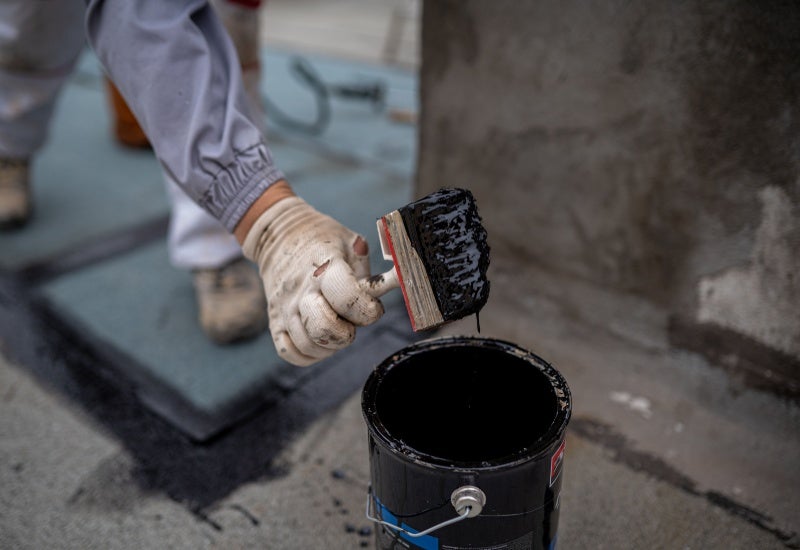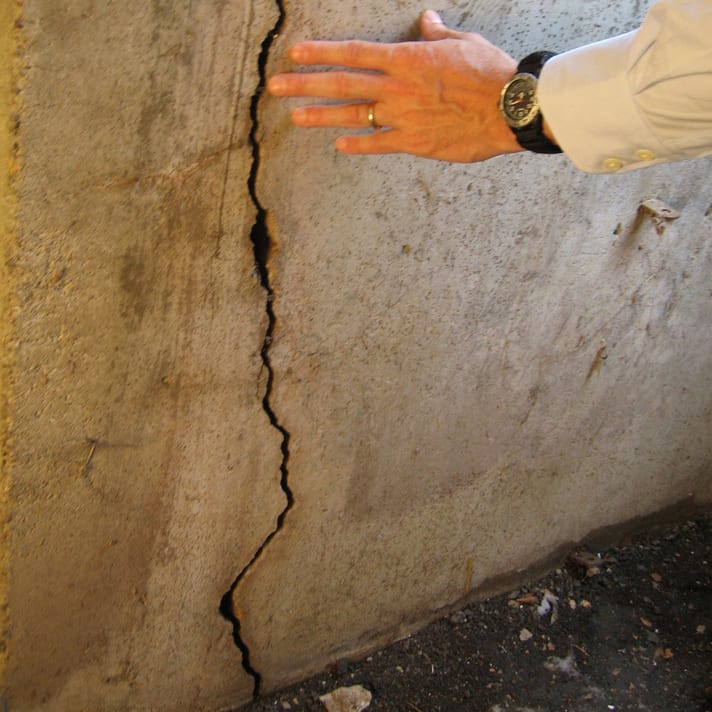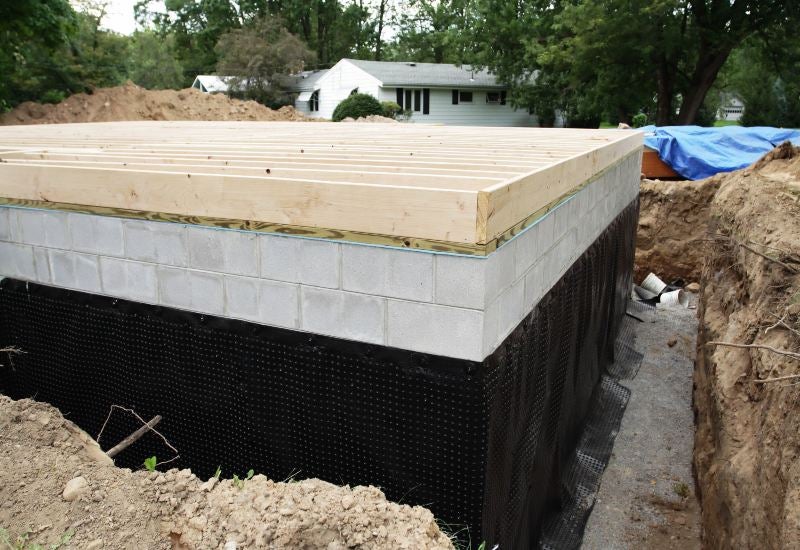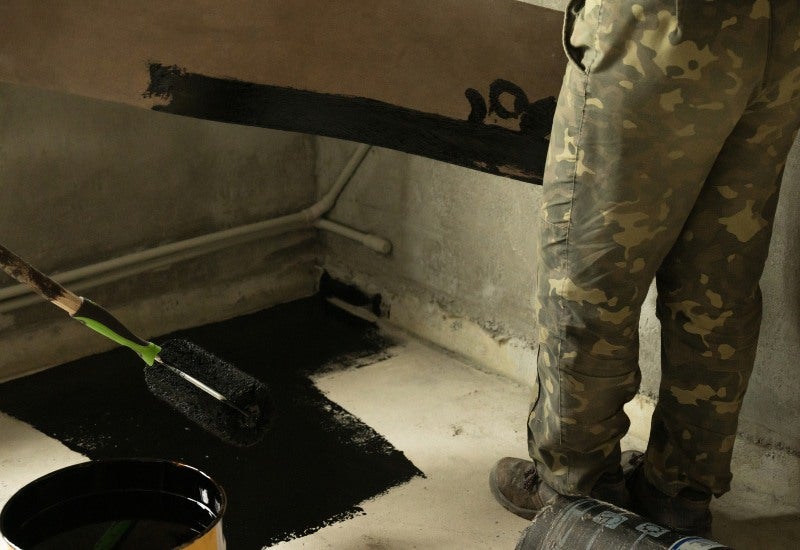-
Is Interior Waterproofing Different from Exterior Waterproofing?
Is Interior Waterproofing Different from Exterior Waterproofing?
At Triad Basement Waterproofing, we know that managing moisture and preventing water damage is key to maintaining the structural integrity of a building. In areas prone to heavy rain or where basements are below the water table, waterproofing can be especially important. Our professionals have been helping to repair and protect homes from water intrusion and damage since 1987, and today we want to help you learn more about the processes involved in waterproofing. Generally, we can divide the procedure into two categories: interior and exterior. Each method addresses different issues and offers unique benefits and challenges. Today, we will explore both methods in detail, outlining their pros and cons, and distinguish between the two to help you make informed decisions.

Identifying the Problems of Basement Leak
Basement leaks can be a homeowner’s nightmare, leading to costly repairs and significant damage if not addressed properly. Common signs of basement leaks include water stains on walls and floors, musty odors, peeling paint or wallpaper, and accumulation of mold and mildew. These issues typically arise from hydrostatic pressure, which forces water through cracks in the foundation, improper drainage, or issues with the building’s construction material. Identifying the root cause of the leak is the first step towards choosing the appropriate waterproofing method.
What Is Interior Waterproofing?
Interior waterproofing involves addressing water issues from inside the basement or foundation walls. This method typically includes the installation of drain tile systems around the perimeter of the floor, a sump pump to remove water, and the application of sealants on the walls and floor. These techniques are designed to manage water that has entered the building, redirecting it away from the basement and foundation structures.
Pros & Cons of Interior Waterproofing
Pros:
- Cost-effective: Generally less expensive than exterior waterproofing as it involves less labor-intensive excavation work.
- Less intrusive: Does not require extensive landscaping or external alterations to your home.
- Quick installation: Can often be completed in less time than exterior waterproofing.
Cons:
- Reactive approach: Primarily deals with water after it has entered the structure, which can sometimes allow for moisture-related issues to persist.
- Maintenance required: Systems like sump pumps require regular maintenance and electricity to operate.
What Is Exterior Waterproofing?
Exterior waterproofing aims to prevent water from entering the home by treating the exterior walls of the basement or foundation. This method often involves excavating around the house to the full depth of the foundation walls, then applying a waterproof coating or membrane to the exterior walls and installing drainage solutions like a French drain system around the perimeter.
Pros & Cons of Exterior Waterproofing
Pros:
- Proactive solution: Prevents water from entering the structure, addressing the issue before it can cause internal damage.
- Long-term solution: Tends to last longer with less maintenance since it deals directly with external moisture.
- Increases property value: Enhances the overall health of the building structure, potentially raising property value.
Cons:
- High cost: More labor and material intensive, leading to higher costs.
- Disruptive: Requires significant excavation, which can disturb landscaping and take longer to complete.
What is the Difference Between Interior and Exterior Waterproofing Methods?
The key difference between interior and exterior waterproofing lies in their approach and the extent of their application. Interior waterproofing is designed to manage water that has already entered the building, making it a more reactive measure. In contrast, exterior waterproofing is a preventative approach, stopping water before it breaches the foundation walls.
Choosing between interior and exterior waterproofing depends on several factors, such as the severity of the water issue, the construction of the building, the local climate, and budget considerations. In some cases, a combination of both methods may be the most effective way to ensure a dry and healthy basement environment.Call Triad Basement Waterproofing
For over 30 years, Triad Basement Waterproofing has been solving moisture problems in basements across Washington D.C., Virginia, and Maryland. Our professionals are skilled at finding and fixing water leakage issues before they can grow large enough to cause problems with the structural integrity of your home. We have developed state-of-the-art solutions for basement water leakage and structural support. We also remove mold and mildew when it finds its way into your home and craft drainage solutions to make sure these issues don’t happen again. Call us now at (301) 532-7903 or visit our website at Triad Basement Waterproofing to schedule your free consultation.
-
What Causes Concrete Foundation Cracks?
What Causes Concrete Foundation Cracks?
Although our homes are built to be resilient to many things, after some time they tend to wear down. In the same way we show signs of age through wrinkles, our homes show it through imperfections and cracks. With the flaws of imperfect construction, pressure surrounding the home and the weight of the house bearing down on it, the foundation of your home takes it all. When it comes to foundation cracks or repairs, the important thing is to take care of the issue as soon as possible. It’s not a good idea to forget about it and wait until the crack gets bigger and allows water to leak into your basement and flood your home.
All concrete has the tendency to crack and there is no way to produce crack-free concrete. Concrete expands and shrinks with changes in temperature and moisture and this can cause cracking early on. Often concrete foundation cracks are not detected until long after they’ve formed. Regardless of how long the crack has been there, it tends to concern homeowners and they worry about the imperfection.
Cracks in concrete foundation most often appear at weak points like corners, basement window frames, walls and pipe areas. It’s important to keep track of these cracks and notice if they are getting bigger. It’s also important to understand why the crack showed up in the first place. What causes concrete foundation cracks? Read on to find out!

Top Causes of Concrete Foundation Cracks
Drought or too much moisture
Soil shrinks like a sponge when moisture is removed from it and when that happens it pulls away from the foundation of your home creating a gap. This gap allows for the foundation to move. When the foundation of a home is not supported properly it can shift around and cracks will begin to appear. In turn, if there is too much moisture it will cause the soil that is supporting the foundation of your home to expand.
Earthquakes
When an earthquake occurs it causes the ground to shake, which in turn shakes your home around. Thankfully not too many earthquakes occur on this side of the U.S., however even the tiniest of quivers can be an issue. Remember, if the foundation isn’t supported or stable, it can move around, weaken and crack. A small earthquake may not cause new cracks, but it can intensify ones that are already present.
Storms
Whether you experience a hurricane, a nor’easter or just a typical rainstorm these storms produce a lot of water, which can damage the foundation of your home. Too much water will force the soil around the foundation of your home to expand, which will push up against the home and cause concrete foundation cracks. Storms can also cause various other structural problems if you don’t take preventive measures to secure your home. One of the most popular explanations behind concrete foundation cracks is the freeze and thaw cycle during the winter. Concrete freezes at around 18 degrees and then it melts at around 35 degrees, which is when the cracking develops.
Plumbing Leaks
It’s important to make sure your pipes are secured and aren’t leaking and that you don’t have any plumbing leaks in your home. If you’re home isn’t equipped with basement waterproofing or a sump pump, the excess water will add to the soil causing it to expand and push against your foundation.
Flooding
Regardless of whether the flooding comes from a storm, a leak, inadequate drainage or something else, too much water will be a problem for your concrete foundation. When hydrostatic pressure becomes too much for the foundation of your home you will notice more leaks, more cracks and more problems.
Extreme Heat
Concrete can also crack under extreme sun and heat because it causes the concrete to expand. During the day and under the sun the concrete will expand, and then overnight the concrete will shrink and retreat back to its original unbaked position.
Get Help Fixing Your Cracks
The moral of the story is that it is important to keep your foundation stable, dry and supported.
When your foundation has wiggle room due to dry soil or if it’s tightly pushed in by expanding soil, these movements cause it to weaken and in turn create concrete foundation cracks. The good news is that concrete foundation cracks that are a result of too much moisture and flooding can be prevented through various methods of basement waterproofing.
It’s also not too difficult to repair concrete foundation cracks with epoxy injections. If you are thinking about preventive measures or you need concrete repair, then contact the team at Triad Basement Waterproofing and they will create a custom solution to your specific situation.
-
Top 3 Methods of Basement Waterproofing
Top 3 Methods of Basement Waterproofing
A dry basement is not only essential for the structural integrity of your home, but also for maintaining a healthy living environment. Basement waterproofing is a key step in protecting your property from moisture related issues. Triad Basement Waterproofing offers comprehensive solutions to keep your basement dry and safe.

Causes of Moisture in the Basement
Before discussing the methods of basement waterproofing, it’s important to understand the common causes of basement moisture. Water can infiltrate your basement through various means, including:
- Groundwater Seepage – Water from the surrounding soil can seep through the basement walls and floor due to hydrostatic pressure. This pressure builds up when the soil around your home becomes saturated, pushing water through any available gaps or cracks.
- Surface Water Infiltration – Improperly graded landscapes can cause rainwater or melting snow to flow toward your foundation, leading to leaks. This often occurs when the ground slopes toward the house instead of away from it, allowing water to pool around the foundation.
- Plumbing Leaks – Faulty plumbing systems can introduce unwanted moisture into your basement. Leaky pipes, water heaters, or fixtures can cause continuous moisture problems if not addressed promptly.
- Condensation – High humidity levels in the basement can result in condensation, creating damp conditions. This often happens in basements with poor ventilation, where warm, moist air meets cooler surfaces.
Understanding these causes helps in choosing the right waterproofing method tailored to your specific needs.
Basement Waterproofing Methods
There are several effective methods to waterproof your basement, each catering to different causes and severities of moisture problems. Here are the top 3 methods:
-
Interior Basement Waterproofing
Interior basement waterproofing focuses on managing water that enters your basement. This method typically involves installing a drainage system that directs water to a sump pump, which then expels the water out of your basement. Key components of interior waterproofing include:
- French Drains – These are perforated pipes installed along the perimeter of the basement floor, channeling water to the sump pump.
- Sump Pumps – These devices are essential for pumping out the collected water to keep your basement dry.
- Vapor Barriers – These barriers are installed on basement walls to prevent moisture from seeping through.
-
Exterior Basement Waterproofing
Exterior basement waterproofing addresses water issues from the outside before they can penetrate the basement walls. This method is considered highly effective as it prevents water from entering your home altogether. Key components of exterior waterproofing include:
- Excavation – This process involves digging around the foundation to apply waterproofing materials directly to the exterior walls.
- Membranes – Waterproof membranes are applied to the foundation walls to create a water-resistant barrier.
- Drainage Systems – Installing exterior drainage systems, such as footing drains, helps divert water away from the foundation.
-
Interior Sealants
Interior sealants are used to seal cracks and gaps in basement walls and floors to prevent moisture ingress. This method is suitable for minor leaks and can be a quick and cost-effective solution. Key components of interior sealants include:
- Epoxy Injections – These are used to fill cracks in the walls, providing a strong and durable seal.
- Silicone-Based Sealants – These sealants are applied to joints and gaps to block moisture entry.

Advantages of Basement Waterproofing
Basement waterproofing offers numerous benefits that go beyond just keeping your basement dry:
-
-
- Enhanced Structural Integrity –Waterproofing helps prevent water damage that could weaken the foundation and structure of your home. By stopping water infiltration, you reduce the risk of foundation cracks and shifting.
- Improved Air Quality – By keeping moisture out, waterproofing reduces the risk of mold and mildew growth, promoting healthier indoor air quality. This is especially important for families with allergies or respiratory issues.
- Increased Property Value – A dry, well-maintained basement can add to the overall value of your home. Potential buyers often view a waterproof basement as a sign of proper home maintenance and care.
- Additional Living Space—Waterproofing allows you to utilize your basement as a functional and comfortable living area. Whether you want to create a home gym, office, or an additional bedroom, a dry basement provides the perfect foundation for your plans.
-
By understanding the causes of basement moisture and implementing the right waterproofing methods, you can safeguard your home effectively. Triad Basement Waterproofing is here to help you every step of the way, offering professional solutions tailored to your specific requirements. Protect your home today and enjoy a dry, safe basement for years to come.
Choose Triad Basement Waterproofing in Gaithersburg, MD
Triad Basement Waterproofing in Gaithersburg, MD, is your trusted partner in basement waterproofing solutions. With years of experience and a commitment to quality, our team provides reliable services to protect your home from moisture-related issues. We offer a comprehensive range of services, from interior and exterior waterproofing to expert advice on maintaining a dry basement.
Contact us today to schedule a consultation and learn more about how we can help keep your basement dry and secure. Visit our website at Triad Basement Waterproofing to explore our services and discover why homeowners in Gaithersburg trust us for their waterproofing needs.
